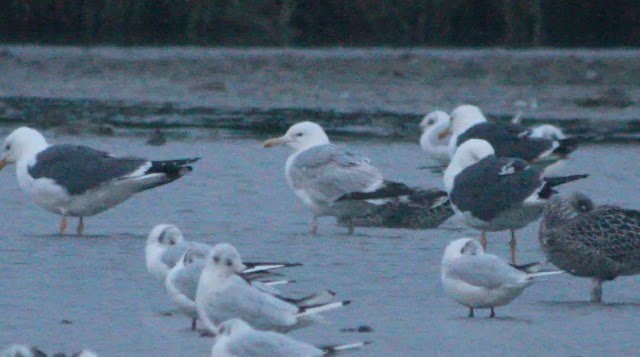An arrival of migrants on Sunday afternoon meant we were keen to get back up to Holy Island on Monday. Thankfully it did not disappoint!
After an early start, we arrived on the island at half seven. The sun was out and without any wind it was feeling pretty warm already. We started at Chare Ends and our very first bird of the day was a brilliant
Wood Warbler in the sycamores, the first time I'd seen one on passage. We had a good feeling about the day at that point!
The rest of the bushes there held good numbers of common migrants. When we reached the willow in between Chare Ends and The Excavations my dad whistled me around to his side of the tree. He'd found an
Icterine Warbler! The bird showed well as it made the most of the morning heat. It also shared the willow with 2
Spotted Flycatchers, a
Pied Flycatcher, a
Garden Warbler and some
Willow Warblers.
In a willow near the Excavations I managed my third self-found
Wryneck in five days. It was interesting to see it being mobbed by a
Willow Warbler. Shortly after my dad found a different
Wryneck at Chare Ends. Both birds were quite flighty and failed to provide a good photo opportunity. There was no scarcities at the Straight Lonnen or in the village, but more common migrants kept our spirits up.
By now the number of tourists had built, so we decided to head down to the Snook. At the plantation I got a very brief view of a bird that I was sure was a
Barred Warbler. After another hour it didn't show again, but was confirmed later by other observers. There was also 3
Pied Flycatchers, 2
Spotted Flycatchers and 4
Garden Warblers in here.
In the Snook House garden I spotted another
Icterine Warbler in the sycamores. A few brief views only of this bird. Just to the west the juvenile
Red-backed Shrike was showing. After some fieldcraft and a coating of Pirri-Pirri Birs I got a photo of the Shrike which I'm quite pleased with.
Also on the Snook we missed yet another Icterine Warbler and Wryneck which had been seen by others. 5
Whinchats were perched on a dune slack here. When we came back to the plantation to try and get another view of the Barred Warbler, three birders told us about a Greenish Warbler that they'd found at the Excavations, and showed us a good photo of it. Having only seen about a second of a Greenish Warbler before I successfully persuaded my dad to drive us back into the village.
Once we had legged it through the dunes and reached the Excavations we started searching. Forty minutes later we could only find a single
Reed and
Willow Warbler, so started to head back to the car. On the way back we noticed a movement in the last willow in the Excavations. Then out popped the
Greenish Warbler! This brilliant little bird gave us some great views as it actively moved about in the bushes, and I enjoyed hearing it call once. It took a while to get a photo of it in the open as it never stayed still for very long. By the time I managed the light was starting to fade.
After 11 hours we were completely exhausted but very happy with our day on Holy Island. Here's the full migrant counts...
1
Greenish Warbler
2
Icterine Warbler
1
Barred Warbler
2
Wryneck
1
Red-backed Shrike
1
Wood Warbler
20
Garden Warbler
20
Pied Flycatcher
8
Spotted Flycatcher
4
Redstart
10
Whinchat
39
Willow Warbler
12
Chiffchaff
1
Whitethroat
1
Blackcap
2
Reed Warbler
 |
| Greenish Warbler |
 |
| Red-backed Shrike |
 |
Icterine Warbler and Willow Warbler in the willow between Chare Ends and the Excavations.
Icterine Warbler in the garden at Snook House.
|
 |
| Wood Warbler |
 |
| Spot the Wryneck! |
 |
| Pied Flycatchers |
 |
| Redstart |
 |
| Garden Warbler |
 |
| Whinchats |
 |
| Willow Warbler |


























































